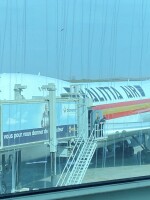A snarl of air traffic over California last week is being blamed on a Cold War-era spy plane whose flight plan did not compute for air traffic control computers. After the altitude of the U-2 plane was misinterpreted, efforts to route airliners around it created havoc.
"According to sources, the U-2 was flying at 60,000 feet," says NBC News, which first reported the story, "but the computers were attempting to keep it from colliding with planes that were actually miles beneath it."
The incident last Wednesday afternoon was centered at the LA Air Route Traffic Control Center in Palmdale, Calif., whose responsibilities include Los Angeles International and airports in San Diego and Las Vegas.
Attempts to reconcile vastly different flight plans "overloaded" the computer system, NBC says, and traffic problems cascaded. From the Los Angeles Times:
"The FAA issued a nationwide ground stop for planes heading into the airspace managed by the Palmdale center, disrupting travel in many cities. At LAX, officials reported 27 flight cancellations, 212 delays and 27 diversions in connection with the problem."
The agency confirmed the incident in a statement that NBC's Andrew Blankstein quotes: "The extensive number of routings that would have been required to de-conflict the aircraft with lower-altitude flights used a large amount of available memory and interrupted the computer's other flight-processing functions."
The U-2's return to the headlines comes 54 years after the plane became famous when U.S. pilot Francis Gary Powers crashed one in the Soviet Union.
As NPR's Larry Abramson reported in 2012, today's U-2 has a slightly different design — along with wildly different electronics and a stronger engine — than previous generations. But its days seem numbered: The Air Force has been looking to phase out the U-2 in favor of its Global Hawk spy drone.
Copyright 2020 NPR. To see more, visit https://www.npr.org.




